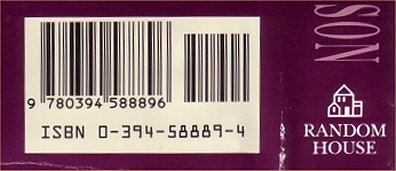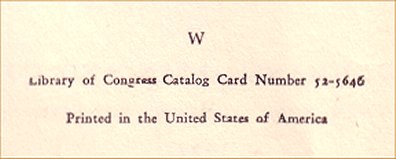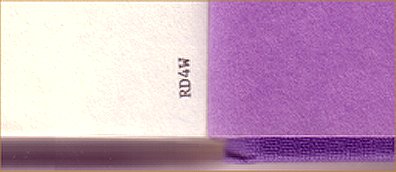

|
If there's a dust jacket, this may tell the terrible tale. The absence of a price will usually mean you have a BCE, whether it's a BOMC edition or not, but keep in mind that prices appeared on some BOMC dust jackets for a period of time in the 1970's. Fortunately these books possessed blind stamps as well, and the dust jackets themselves bore two betraying statements on the front flap: "Selection of the Book-of-the-Month Club" at the top (followed by an asterisk) and "Trademark of the Book-of-the-Month Club" at the bottom (preceded by an asterisk). Example: Graham Green's Travels With My Aunt.  
Several words of warning about dust jackets: A dust jacket that appears to have been price-clipped doesn't necessarily demonstrate that a price was present at one time. A book club dust jacket without a price may have been clipped to mislead a buyer. Another tactic used by unscrupulous sellers is to marry a second edition dust jacket (in the case where it's identical to a first edition dust jacket) to a book club edition that's otherwise difficult to distinguish from the first trade edition. Important note: Some trade edition dust jackets also lack prices. Another point about statements on dust jackets: the statement "Selection of the Book-of-the-Month Club" alone isn't definitive in identifying a book as a BCE. Occasionally this statement or a similar one appeared on first trade edition dust jackets as well for promotional purposes. On modern titles that possess bar codes on the back of the dust jacket, look closely for telltale indications. On BOMC titles in particular the number string found on trade editions on top of the far right bar grouping is usually (but not always) missing. The complete absence of a bar code may also be indicative of BCE status if it can be established that the trade edition possesses one.

There are textual indications than can assist in the identification process. The absence of typical publisher's designations for first editions - for example, the words "First Edition" or a number string on the copyright page - may be (but by no means necessarily are) absent in BOMC editions. BOMC publications which retain these designations - and there are more than a few - are frequently misrepresented as first editions by sellers who may or may not know better. Also, in some early BOMC editions, a W appears on the copyright page.

A gutter code may be present on some BOMC editions of more recent vintage. This is typically a vertically printed alphanumeric string deep in the gutter of the last page inside the endpaper. If the endpaper is glued over it, partially or completely, sometimes this can be read through the opposite side of the page or revealed by carefully peeling the pages apart.

Finally, many booksellers assume that most BOMC editions are inferior in quality to their trade counterparts - this was and remains most definitely the case with the BOMC's primary competitor, the Literary Guild - but it's not often understood that BOMC editions were different animals in this respect. Even after the BOMC took over publishing themselves (July, 1930), with few exceptions they adhered to a policy of producing books that were equal in format and quality to the original publisher's books. In some cases, in fact, binder's boards were superior in quality. And talk about complexity - there were instances when trade publishers ran off their own editions simultaneously with BOMC's in the same plants! And here - how does one even begin to nail down edition state??? But even when trade and BOMC books were printed in different plants, great care was taken by the BOMC to duplicate trades. This is an important point to keep in mind because in part it explains why collectors find BOMC editions of collected authors desirable and, conversely, Literary Guild, Doubleday Book Club, et al editions not.
Identifying Literary Guild Editions
|

|